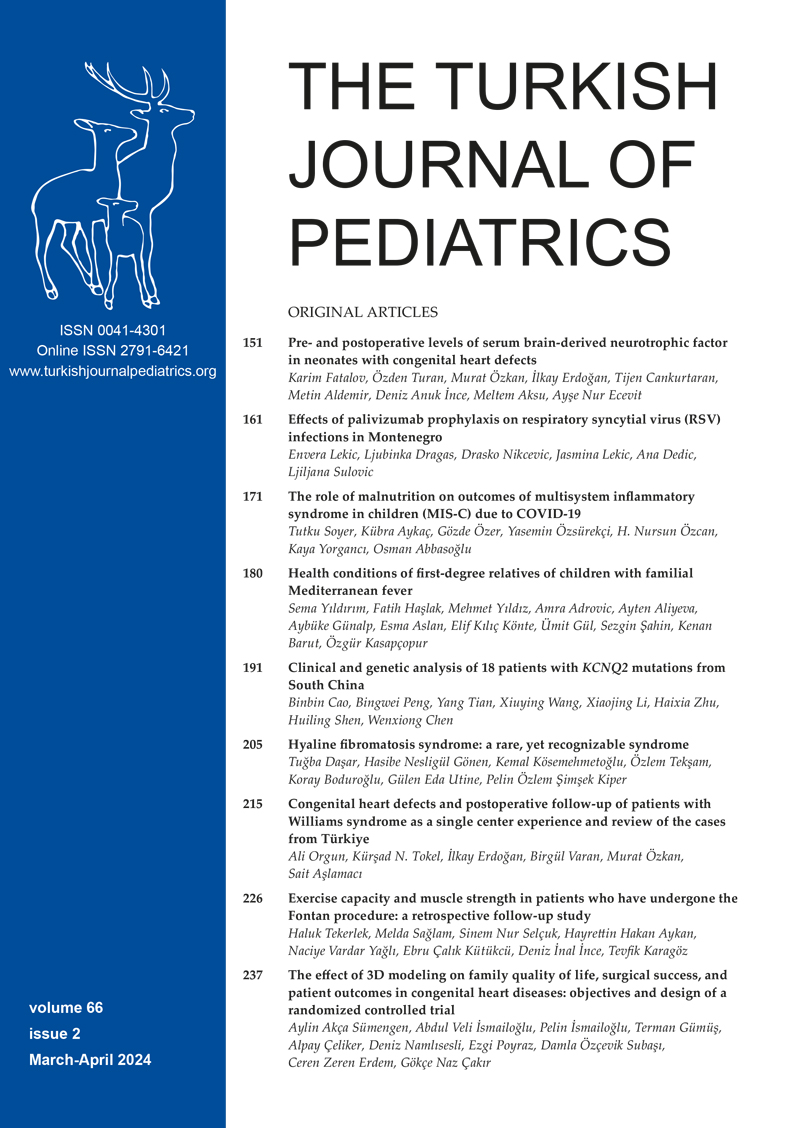Abstract
Background. Acute respiratory failure is a prevalent condition in childhood with a high rate of mortality. Invasive mechanical ventilation support may be required for the management of these patients. Extracorporeal membrane oxygenation (ECMO) is a method used when ventilation support is insufficient. However, the less invasive extracorporeal carbon dioxide removal method can be used as an alternative in cases of hypercapnic respiratory failure.
Case. A 9-year-old patient with cystic fibrosis presented to the hospital with acute respiratory failure due to pneumonia. Bilateral patchy areas of consolidation were evident in the chest x-ray. Invasive mechanical ventilation support was consequently provided to treat severe hypercapnia. Although peak and plateau pressure levels exceeded 32 cmH₂O (49 cmH₂O) and 28 cmH₂O (35 cmH₂O), respectively, the patient continued to have severe respiratory acidosis. Therefore extracorporeal carbon dioxide removal support was initiated to provide lung-protective ventilation. By Day 10, venovenous ECMO support was initiated due to deteriorating oxygenation.
Conclusion. In cases where conventional invasive mechanical ventilation support is insufficient due to acute hypercapnic respiratory failure, extracorporeal carbon dioxide removal support, which is less invasive compared to ECMO, should be considered as an effective and reliable alternative method. However, it should be noted that extracorporeal carbon dioxide removal support does not affect oxygenation; it functions solely as a carbon dioxide removal system.
Keywords: extracorporeal carbon dioxide removal, extracorporeal membrane oxygenation (ECMO), hypercapnic respiratory failure, pediatric intensive care unit
References
- Giraud R, Bendjelid K, Banfi C. Obesity-related respiratory failure: a new area for extracorporeal lung support? Swiss Med Wkly 2018; 148: w14651. https://doi.org/10.4414/smw.2018.14651
- Omecinski K, Cove M, Duggal A, Federspiel W. Extracorporeal carbon dioxide removal (ECCO2R): a contemporary review. Appl Eng Sci 2022; 10: 100095. https://doi.org/10.1016/j.apples.2022.100095
- Combes A, Fanelli V, Pham T, Ranieri VM, European Society of Intensive Care Medicine Trials Group and the “Strategy of Ultra-Protective lung ventilation with Extracorporeal CO2 Removal for New-Onset moderate to severe ARDS” (SUPERNOVA) Investigators. Feasibility and safety of extracorporeal CO2 removal to enhance protective ventilation in acute respiratory distress syndrome: the SUPERNOVA study. Intensive Care Med 2019; 45: 592-600. https://doi.org/10.1007/s00134-019-05567-4
- Burki NK, Mani RK, Herth FJF, et al. A novel extracorporeal CO(2) removal system: results of a pilot study of hypercapnic respiratory failure in patients with COPD. Chest 2013; 143: 678-686. https://doi.org/10.1378/chest.12-0228
- Schouten LRA, Veltkamp F, Bos AP, et al. Incidence and mortality of acute respiratory distress syndrome in children: a systematic review and meta-analysis. Crit Care Med 2016; 44: 819-829. https://doi.org/10.1097/CCM.0000000000001388
- Friedman ML, Nitu ME. Acute respiratory failure in children. Pediatr Ann 2018; 47: e268-e273. https://doi.org/10.3928/19382359-20180625-01
- Yañez LJ, Yunge M, Emilfork M, et al. A prospective, randomized, controlled trial of noninvasive ventilation in pediatric acute respiratory failure. Pediatr Crit Care Med 2008; 9: 484-489. https://doi.org/10.1097/PCC.0b013e318184989f
- Nishisaki A, Turner DA, Brown CA, et al. A national emergency airway registry for children: landscape of tracheal intubation in 15 PICUs. Crit Care Med 2013; 41: 874-885. https://doi.org/10.1097/CCM.0b013e3182746736
- Schmidt M, Jaber S, Zogheib E, Godet T, Capellier G, Combes A. Feasibility and safety of low-flow extracorporeal CO2 removal managed with a renal replacement platform to enhance lung-protective ventilation of patients with mild-to-moderate ARDS. Crit Care 2018; 22: 122. https://doi.org/10.1186/s13054-018-2038-5
- Giraud R, Banfi C, Assouline B, De Charrière A, Cecconi M, Bendjelid K. The use of extracorporeal CO2 removal in acute respiratory failure. Ann Intensive Care 2021; 11: 43. https://doi.org/10.1186/s13613-021-00824-6
- Kluge S, Braune SA, Engel M, et al. Avoiding invasive mechanical ventilation by extracorporeal carbon dioxide removal in patients failing noninvasive ventilation. Intensive Care Med 2012; 38: 1632-1639. https://doi.org/10.1007/s00134-012-2649-2
- Combes A, Auzinger G, Capellier G, et al. ECCO2R therapy in the ICU: consensus of a European round table meeting. Crit Care 2020; 24: 490. https://doi.org/10.1186/s13054-020-03210-z
- Beloncle F, Brochard L. Extracorporeal Co2 removal for chronic obstructive pulmonary disease: too risky or ready for a trial? Crit Care Med 2015; 43: 245-246. https://doi.org/10.1097/CCM.0000000000000677
- Bozkuş F, Bilal B, Öksüz H. Extracorporeal carbondioxide removal (ECCO2R): case series and review of literature. Tuberk Toraks 2018; 66: 258-265. https://doi.org/10.5578/tt.26368
- Del Sorbo L, Fan E, Nava S, Ranieri VM. ECCO2R in COPD exacerbation only for the right patients and with the right strategy. Intensive Care Med 2016; 42: 1830-1831. https://doi.org/10.1007/s00134-016-4493-2
- Cardenas VJ, Miller L, Lynch JE, Anderson MJ, Zwischenberger JB. Percutaneous venovenous CO2 removal with regional anticoagulation in an ovine model. ASAIO J 2006; 52: 467-470. https://doi.org/10.1097/01.mat.0000227743.07743.5d
- Fanelli V, Ranieri MV, Mancebo J, et al. Feasibility and safety of low-flow extracorporeal carbon dioxide removal to facilitate ultra-protective ventilation in patients with moderate acute respiratory distress syndrome. Crit Care 2016; 20: 36. https://doi.org/10.1186/s13054-016-1211-y
- Moss CE, Galtrey EJ, Camporota L, et al. A Retrospective observational case series of low-flow venovenous extracorporeal carbon dioxide removal use in patients with respiratory failure. ASAIO J 2016; 62: 458-462. https://doi.org/10.1097/MAT.0000000000000386
- Giraud R, Banfi C, Assouline B, De Charrière A, Bendjelid K. Very low blood flow carbon dioxide removal system is not effective in a chronic obstructive pulmonary disease exacerbation setting. Artif Organs 2021; 45: 479-487. https://doi.org/10.1111/aor.13867
Copyright and license
Copyright © 2024 The Author(s). This is an open access article distributed under the Creative Commons Attribution License (CC BY), which permits unrestricted use, distribution, and reproduction in any medium or format, provided the original work is properly cited.















